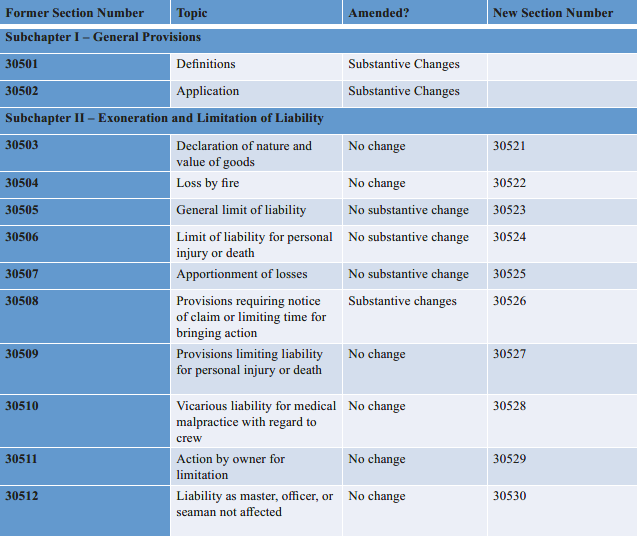Navigating the "Amendments" to the Shipowner’s Limitation of Liability Act
This article was co-authored by Barrett Hails for Benedict's Maritime Bulletin and was published August 22, 2023.
On December 23, 2022, President Biden signed the James M. Inhofe National Defense Authorization Act for Fiscal Year 2023 into law. PL 117-263, December 23, 2022, 136 Stat 2395. While the overwhelming majority of the lengthy 2400 page legislation addresses financial appropriations related to defense spending, the final “Division K” of the bill’s eleven divisions, entitled the “Don Young Coast Guard Authorization Act of 2022,” contains several significant amendments impacting the maritime industry. This includes Section 11503, which amends the Limitation of Liability Act, 46 U.S.C. §§ 30501, et seq. (the “Limitation Act”), to specifically exclude its application to “covered small passenger vessels” while maintaining its application for owners and operators of “seagoing vessels and vessels used on lakes and rivers or in inland navigation.” § 30502.
A. Introduction of Legislation to Modify the Limitation Act
While the Limitation Act has been no stranger to criticism over the years, this most recent amendment was originally introduced by Senator Dianne Feinstein (D-CA) and Representative Salud Carbajal (CA-24) in 2021 following the fire aboard the dive boat CONCEPTION off the coast of California in September 2019 which resulted in the loss of thirty-three passengers and one crewmember. The originally proposed legislation, entitled the “Small Passenger Vessel Liability Fairness Act of 2021” required, in part, that the “Coast Guard to promulgate rules that require owners or operators of small passenger vessels to provide just compensation in any claim for which they are found liable.” Further, the legislation would have been retroactive to be effective as of the date of the CONCEPTION casualty.
B. The Final Legislation
The retroactive effective date, which would have had far reaching implications for essentially all prior marine causalities, did not survive bipartisan negotiation, and the final legislation passed by Congress and signed into law on December 23, 2022, is more limited in scope, essentially carving small passenger vessels out of the Limitation Act, among other changes discussed below, and, significantly, contains no language as to its retroactivity.[1] For reasons unclear, the amendment renumbers certain sections. Practitioners will recall that previously the Limitation Act was codified as 46 U.S.C. § 181 et seq. but in 20016, was changed to 46 U.S.C. § 30501 et seq. The Limitation Act amendments renumber all sections following Section 30502, and, specifically, prior Sections 30503 through 30512 are now renumbered consecutively as Sections 30521 through 30530. No mention is made of the Supplemental Rules for Certain Admiralty or Maritime Claims and Asset Forfeiture Actions, in particular Supplemental Rule F which is entitled “Limitation of Liability” and refers to many procedures for vessel limitation actions.
The primary amendments to the Limitation Act are contained in Sections 30501 and 30502 entitled “Definitions” and “Application” respectively, as well as in Section 30526 entitled “Provisions requiring notice of claim or limiting time for bringing action”
1. Exclusion of “Covered Small Passenger Vessels”
The “Application” section, Section 30502, includes a new subsection ((b)), which reads “Exception- This chapter (except for section 30526) shall not apply to covered small passenger vessels.” In other words, if the vessel qualifies as a “covered small passenger vessel”, by the terms of Section 30502, it should be excluded from the Limitation Act.
Section 30501(1)(A) now defines a “covered small passenger vessel” as a “small passenger vessel, as defined in [46 U.S.C. § 2101] that is (i) not a wing-in-ground craft; and (ii) carrying – (I) not more than 49 passengers on an overnight domestic voyage; and (II) not more than 150 passengers on any voyage that is not an overnight domestic voyage…” 46 U.S.C. § 2101(45) defines a “small passenger vessel” as either a “wing-in-ground” craft carrying at least one passenger for hire; and a vessel of less than 100 gross tons : (A) carrying more than 6 passengers, including at least one passenger for hire; (B) that is chartered with the crew provided or specified by the owner or the owner's representative and carrying more than 6 passengers; (C) that is chartered with no crew provided or specified by the owner or the owner's representative and carrying more than 12 passengers; (D) that is a submersible vessel carrying at least one passenger for hire; or (E) that is a ferry carrying more than 6 passengers. Section 2101(47)(A)-(E). A “covered small passenger vessel” is also expressly defined to include wooden vessels constructed prior to March 11, 1996 which are carrying at least one passenger for hire. § 30502(B). The reason for the inclusion of wooden vessels and the 1996 date is not clear (though the CONCEPTION was a wooden vessel which was covered in fiberglass). Although Section 2101 addresses five categories of vessels as “small passenger vessels” so long as they are less than 100 gross tons, all categories require 12 or less passengers, and therefore, Section 30501, which requires either less than 49 or 150 passengers (depending on the nature of the voyage) effectively creates an additional subcategory of vessels in addition to Section 2101(47).
To summarize, unless the vessel at issue is a wing-in-ground craft, the following vessels appear to be excluded from the Limitation Act:
-
- Wooden vessels constructed prior to March 11, 1996 carrying at least one passenger for hire;
- Vessels less than 100 gross tons carrying 49 or less passengers on an overnight domestic voyage;
- Vessels less than 100 gross tons carrying 150 or less passengers that is not on an overnight domestic voyage.
2. Contractual Time Limits to Bring Actions
In addition to carving out small passenger vessels, another significant substantive change to the Limitation Act is to former Section 30508 (now 30526) which previously addressed contractual time limits for bringing notice of a claim and an action against a seagoing vessel. Section 30526 now adds “covered small passenger vessels” to these provisions setting out the permissible minimum claim time limits and provides that passengers aboard covered small passenger vessels must have no less than two years to provide notice or bring an action after injury or death. Therefore, those operating a covered small passenger vessel may now not contractually limit the time to bring a claim or notice of a claim against them to less than two years from the date of incident. The amendment does not reference or address its impact or relationship to 46 U.S.C. § 30106, which includes its three-year time limit for bringing maritime tort claims for injury or death.
From a practitioner’s perspective, the amendment appears likely to create many questions in the short term. As noted above, no reference is made to Rule F of the Supplemental Rules for Admiralty or Maritime Claims or whether the concursus procedure remains available to those operating “covered small passenger vessels” even if limitation is not available. Further, Rule F expressly references exoneration and contemplates the filing of a complaint in federal court. Supplemental Rule F (2), (5) & (9). The amendments do not refer to any state court procedures, and therefore, whether limitation could still be raised as an affirmative defense is not known. Since no mention is made of whether the amendment is retroactive, questions will undoubtedly be raised as to whether an incident which occurred before the effective date but for which a limitation act was not filed until after the amendment took effect is timely. What if one vessel in a flotilla qualifies as a “covered small passenger vessel” but the other does not? Additionally, it is unclear what result these amendments will have on available marine insurance coverage for owners and operators of “covered small passenger vessels” who arguably may no longer have the benefit of the Limitation Act’s protection. Given the recent adoption, there does not appear to be any judicial guidance on interpreting the amendments at the time of drafting; however, the ultimate impact of carving out “covered small passenger vessels” from the Limitation Act will likely take years to fully evaluate.
The chart below references the prior statutory references with the new references, with a further indication of whether a substantive change has been made.

[1] Source of Amendment:
PL 117-263, December 23, 2022, 136 Stat 2395, James M. Inhofe National Defense Authorization Act for Fiscal Year 2023, (11) Division K “Don Young Coast Guard Authorization Act of 2022” Title CXV – Maritime, Subtitle A- Vessel Safety, Sec. 11503.


